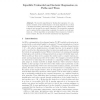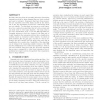822 search results - page 23 / 165 » Descendants in Increasing Trees |
PROCEDIA
2010
13 years 2 months ago
2010
The field of bioinformatics is witnessing a rapid and overwhelming accumulation of molecular sequence data, predominantly driven by novel wet-lab sequencing techniques. This trend...
LATIN
2010
Springer
14 years 2 months ago
2010
Springer
Abstract. We describe algorithms for finding the regression of t, a sequence of values, to the closest sequence s by mean squared error, so that s is always increasing (isotonicit...
ICMLA
2008
13 years 9 months ago
2008
Using decision trees that split on randomly selected attributes is one way to increase the diversity within an ensemble of decision trees. Another approach increases diversity by ...
BMCBI
2006
13 years 7 months ago
2006
Background: In the genomic age, gene trees may contain large amounts of data making them hard to read and understand. Therefore, an automated simplification is important. Results:...
KDD
2002
ACM
14 years 8 months ago
2002
ACM
Recently there has been an increasing interest in developing regression models for large datasets that are both accurate and easy to interpret. Regressors that have these properti...


